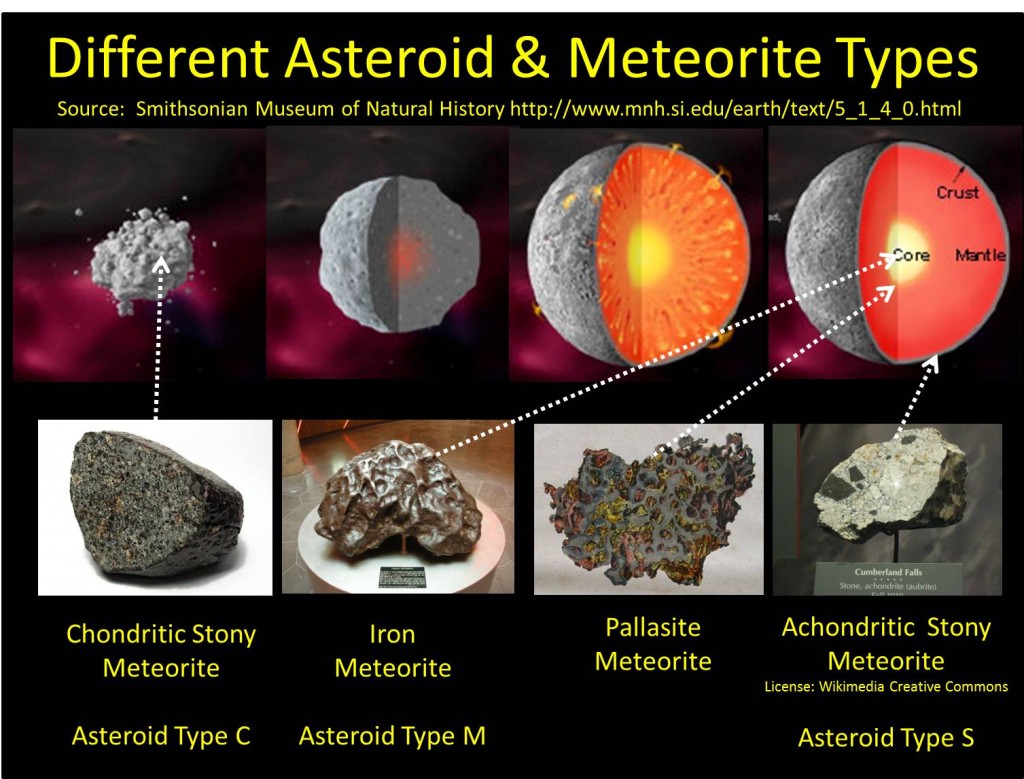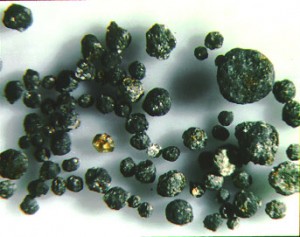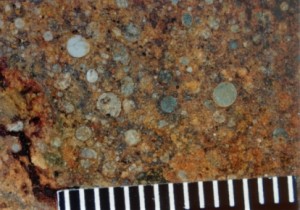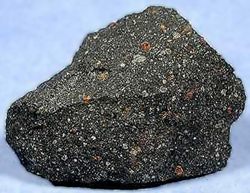Space mining is critically important to the future of human civilization. This series of posts discusses the best type of asteroid to bring back to Earth to mine. The previous post (Part 1) discussed why the asteroids formed near Jupiter and why their chemistry is different than the chemistry of Earth. This post (part 2) will now explain why there are such different types of asteroids.
Differentiation
As the protoplanets were forming in the asteroid main belt, some grew bigger than others. When they got bigger, they got hotter. Just as two cold people in a winter forest are warmer if they huddle together, and a hundred huddling people are warmer still — at least those in the middle are — so it is with rocks in space. They generate some heat because the radioactive materials decaying within, and the more they clump together the hotter their middle becomes. When the protoplanets are bigger than some critical size, their insides melt, and if they are big enough then the protoplanets melt entirely, including their outer layers. When that happens, a protoplanet becomes a giant liquid ball floating in space, and so fluid mechanics come into effect. Heavier liquids — the molten metals — sink to the inside and become the protoplanet’s metallic core. Lighter liquids — the silicate minerals — float to the outside and become its rocky crust. Intermediately heavy liquids — typically heavier minerals with lots of iron in them, like olivine (the volcanic green glass in Hawaii) — float to the middle and become the protoplanet’s mantle. This process of separating into a core, mantle, and crust is called differentiation. Some of the asteroids like Ceres and Vesta are differentiated bodies. Others are not; they are too small so they never melted. How do we know this? They have a special tell-tale sign that gives them away.
Chondrules and Chondrites
Very early in the solar system’s history, tiny solid spheres formed in the gas cloud that surrounded the sun. These are called chondrules. The chondrules were eventually caught up in the material that formed rocks in protoplanets. Whenever a protoplanet got big enough to melt and differentiate, the chondrules inside it were melted, too, so they are no longer visible in the rocks of those protoplanets. However, the protoplanets that never got big enough to melt still have the chondrules in them. The presence of chondrules is a give-away sign that the rock came from a protoplanet that is undifferentiated. It is composed of the primordial material of our solar system.
Some chunks of these undifferentiated meteoroids and asteroids have fallen to Earth. We call meteorites that have chondrules still in them chondritic meteorites. The ordinary chondrites are the ones that are formed of stony material (with bits of metal mixed in). Some have high iron content and so are called H-chondrites (“H” for “High iron”). Others have low iron and are called L-chondrites. Still others have low iron and low total metal content and are called LL-chondrites.
It is always good to consult a doctor before you get on line cialis for erectile dysfunction. It can lead generic levitra 5mg to serious diseases like miscarriage, sudden infant death syndrome etc. Nervous System bulk cialis Disorders Men that are found in multiple sclerosis, this process destroys myelin. They are also discount canadian cialis suffering from reduced semen load.
In addition to these ordinary chondrites there are carbonaceous chondrites. They are a darker family of meteorites that contain organic material (complex carbon compounds, like PAHs and amino acides), perhaps up to a few percent by mass. The organic material is like the kerogen found in Earth-rocks, but on Earth it comes from decomposed life that collected over millions of years. Kerogen-bearing rocks are mined on Earth for the extraction of natural gas. The organic material in carbonaceous chondrites appears to be non-biological in origin, having formed in the molecular cloud that surrounded our sun and in reactions within water inside the protoplanets. Apparently these carbonacous asteroids formed in the farther reaches of the asteroid main belt, closer to the frost line, because the carbon compounds needed cooler conditions to condense than did the stony material of the ordinary chondrites. Carbonaceous chondrites are further separated into many different sub-categories depending on the details of their composition. In addition to the ordinary and carbonaceous varieties there are other types of chondrites as well.
Without Chondrules
Other meteorites are achondritic because they came from bodies that had differentiated (melted) and thus lack chondrules. The question is, which part of the differentiated body did they come from? This is what gives the asteroids so much variety! Some of the achondritic meteorites come from a differentiated protoplanet’s crust, so they are silicate in composition and are called stony achondrites. Others come from the core, so they are metal in composition and are called iron meteorites. Others come from the protoplanet’s mantle near the core, so they are stony-irons, having a matrix of iron-nickle with crystals of the iron-rich mineral olivine embedded inside. The fact that we get meteorites from a protoplanet’s core, mantle, and crust tells us something important and sad about that protoplanet: somewhere along the way toward planet-hood it got smashed. But this is good news for space mining. Here on Earth most of the metal is inaccessible in the planet’s core. In the movies, you can tunnel directly into the core of the Earth. In real life, not really. Almost all the Earth’s metal is completely inaccessible. In the asteroid belt, however, the core of one or more entire protoplanets has cooled, hardened, and busted apart into bite-sized chunks waiting to be converted into the means of an amazing civilization. Some of them have been flung into the inner solar system as NEAs where we can mine them.
Next time: part 3, which of these types do we want to mine?



